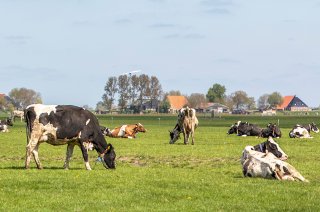
category_news
WUR examines definition of farm and animal density
What do we mean by farm and animal density? Wageningen Bioveterinary Research (WBVR, part of Wageningen University & Research) investigated and tested various definitions at the request of the Ministry of Agriculture, Nature and Food Quality (LNV). This resulted in relatively simple candidate definitions per animal sector that match transmission risks for animal diseases and zoonoses. The definitions provide decentralised authorities with tools for decision-making on the (re)design of rural areas.
For the (re)design of the Dutch landscape, the National Rural Area Programme (NPLG) provides the policy framework. As part of this, governments can consider the risk of animal diseases and zoonoses. This is a so-called co-linking structural choice (MSK) within the NPLG. Governments that include the risk of animal diseases and zoonoses in the (re)design of an area can, among other things, take into account farm and animal densities on site. To do so, a definition of these terms is needed. What do we mean by farm and animal density and what limit values belong to them? Together with several colleagues, Thomas Hagenaars, epidemiologist at WBVR, considered this question on behalf of the Ministry of Agriculture, Nature and Food Quality.
Definition by sector
The study hypothesised definitions. Transmission models for different animal diseases per sector were then used to test possible definitions. It also examined how these definitions relate to the definition of concentration areas from the Fertiliser Act and an existing list of poultry-dense areas related to particulate matter. The study resulted in several candidate definitions. These candidate definitions provide insight into inter-farm transmission risks if an infection occurs.
Poultry
The candidate definition for poultry farming is based on the risk of transmission of avian influenza and uses the number of poultry farms within a 5-kilometre radius. Depending on the established limit of the number of farms in that area, an area can be qualified as either farm- and animal-dense or not using a decision tree.
Pigs
For pig farming, the risk of transmission of classical swine fever as well as the transmission risks of foot-and-mouth disease were used as a test for the decision tree. Here, not only the number of pig farms in an area plays a role, but also the number of farms with ruminants. “In this decision tree, the starting point is the number of livestock farms with pigs and/or ruminants in a 3-kilometre radius and then the number of livestock farms with pigs in a 2-kilometre radius,” says Hagenaars.
Ruminants
For cattle, sheep and goat farming, a 3-kilometre radius provides the best performing definition, the models show. This includes all livestock farms that have cattle, sheep, goats and/or pigs. The transmission risk for foot-and-mouth disease was tested for this model. “Application of the ruminant candidate definition to the current situation in the Netherlands gives rise to several areas classified as farm and animal dense. This is because livestock farms with ruminants are spread across the country and several areas have a high concentration of livestock farms. While the chance of a first farm becoming infected is small, if that happens, there is a high risk of further spread between farms in such areas,” Hagenaars explains.
You can read more about this research in the report ‘Definition of farm and animal density’ (in Dutch). This report was presented to the Tweede Kamer by Minister Piet Adema on Tuesday 23 January 2024. The report provides guidance for further interpretation of the definition by the Ministry of Agriculture, Nature and Food Quality in cooperation with stakeholders.